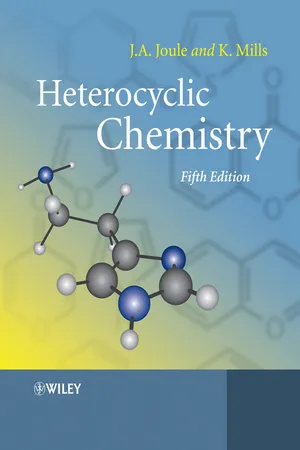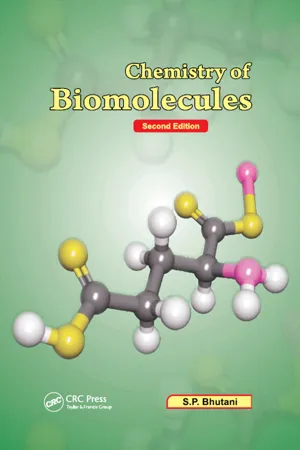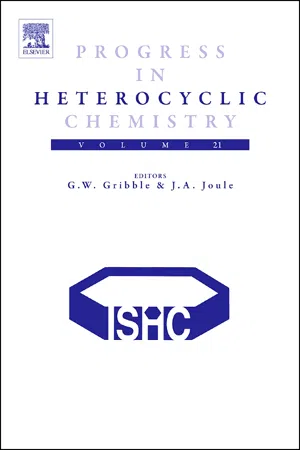Chemistry
Purine
Purine is a heterocyclic aromatic organic compound that consists of a pyrimidine ring fused to an imidazole ring. It is a key component of nucleotides, including adenine and guanine, which are essential for the structure of DNA and RNA. Purines also play a crucial role in various biological processes, such as energy transfer and signaling within cells.
Written by Perlego with AI-assistance
4 Key excerpts on "Purine"
- eBook - ePub
- John A. Joule, Keith Mills(Authors)
- 2013(Publication Date)
- Wiley-Blackwell(Publisher)
27
Purines: Reactions and Synthesis
Purines are of great interest for several reasons, but in particular, together with certain pyrimidine bases, they are constituents of DNA and RNA, and consequently of fundamental importance in life processes (see 32.4). Additionally, as nucleosides and nucleotides they act as hormones and neurotransmitters and are present in some co-enzymes. The interconversion of mono-, di-and triphosphate esters of nucleosides is at the heart of energy transfer in many metabolic systems and is also involved in intracellular signalling. This central biological importance, together with medicinal chemists’ search for anti-tumour and anti-viral (particularly anti-AIDS) agents, have resulted in a rapid expansion of Purine chemistry (33.6.3).There are significant lessons to be learnt from the chemistry of Purines since their reactions exemplify the interplay of its constituent imidazole and pyrimidine rings, just as the properties of indole show modified pyrrole and modified benzene chemistry. Thus Purines can undergo both electrophilic and nucleo-philic attack at carbon in the five-membered ring and mainly nucleophilic reactions at carbon in the six-membered ring.The numbering of the Purine ring system is anomolous and reads as if Purine were a pyrimidine derivative. There are, in principle, four possible tautomers of Purine containing an N -hydrogen; in the crystalline state, Purine exists as the 7H -tautomer, however in solution both 7H- and 9H -tautomers are present in approximately equal proportions; the 1H- and 3H -tautomers are not significant.1The majority of reported Purine chemistry pertains to the naturally occurring Purines, which are amino and/or oxygenated substances and, as a consequence, reactions of the simpler Purines, such as in other chapters are given as typical, have received limited attention. A nomenclature related to the natural Purines has evolved and is in general usage. A ‘nucleoside’ is an N -sugar derivative of a Purine (generally 9-(riboside) or 9-(2′-deoxyriboside)), for example adenosine is the 9-(riboside) of adenine, itself the generally used trivial name for 6-aminoPurine. A nucleotide is a 5′-phosphate (or di-or tri-phosphate) of a nucleoside – adenosine 5′-triphosphate (ATP) is an example. Note that there are comparable pyrimidine nucleosides and nucleotides (32.4). (NOTE: In some diagrams, to save space, for β-D-2-deoxyribofuranosyl, β-D-ribofuranosyl and a generalized sugar, we use ® - eBook - ePub
- John A. Joule(Author)
- 2020(Publication Date)
- CRC Press(Publisher)
Purines: reactions and synthesis23
Purines are of great interest for several reasons, but in particular, together with certain pyrimidine bases, they are constituents of DNA and RNA and consequently of fundamental importance in life processes. Additionally, as nucleosides and nucleotides (see below) they act as hormones and neurotransmitters and are present in some co-enzymes. The interconversion of mono-, di-, and triphosphate esters of nucleosides is at the heart of energy-transfer in many metabolic systems and is also involved in intracellular signalling. This central biological importance, together with medicinal chemists’ search for anti-tumour and anti-viral (particularly anti-AIDS) agents, have resulted in a rapid expansion of Purine chemistry in recent years.There are significant lessons to be learnt from the chemistry of Purines, since their reactions exemplify the interplay of its constituent imidazole and pyrimidine rings just as the properties of indole show modified pyrrole and modified benzene chemistry. Thus Purines can undergo both electrophilic and nucleophilic attack at carbon in the five-membered ring, but only nucleophilic reactions at carbon in the six-membered ring.The numbering of the Purine ring system is anomolous and reads as if Purine were a pyrimidine derivative. There are in principle four possible tautomers of Purine containing an N-hydrogen; in the crystalline state Purine exists as the 7H-tautomer, however in solution both 7H- and 9H-tautomers are present in approximately equal proportions; the 1H- and 3H- tautomers are not significant.1Not surprisingly, because the naturally occurring Purines are amino and/or oxygenated substances, the majority of reported Purine chemistry pertains to such derivatives and, as a consequence, reactions of the simpler examples, such as in other chapters are given as typical, have received limited attention. Since the study of Purines stems from interest in the naturally occurring derivatives, a ‘trivial’ nomenclature has evolved which is in general usage. A nucleoside is a sugar (generally 9-(riboside) or 9-(2′-deoxyriboside)) derivative of a Purine base (or pyrimidine base); for example, adenosine is the 9-(riboside) of adenine, itself the generally used trivial name for 6-aminoPurine. A nucleotide - eBook - ePub
- S. P. Bhutani(Author)
- 2019(Publication Date)
- CRC Press(Publisher)
This synthesis leads to the preparation of Purines that are unsubstituted in position 8. 8-Hydroxy Purines may be prepared by using ethyl chloroformate instead of formic acid. Also, diamino pyrimidines may be fused with urea to produce 8-hydroxy Purines.4.7 ADENINE
Adenine is a Purine derivative. Its structure is given below with standard numbering of positions. It is 6-aminoPurine.A. Structure and General Features
We know adenine is a chemical component of both DNA and RNA. However, it plays a variety of roles in biochemistry including cellular respiration, in the form of both the energy rich adenosine triphosphate (ATP) and the cofactors nicotinamide adenine dinucleotide (NAD+ ) and flavin adenine dinucleotide (FAD), and protein synthesis. The shape of adenine is complementary to either thymine in DNA or uracil in RNA.In addition to nucleic acids, adenine occurs in the pancreas of cattle and in tea extracts. General reactions of adenine are similar to that of Purine. On treatment with nitrous acid, it can be converted into hypoxanthine (an oxyPurine). Its structure was established by synthesis.Adenine forms several tautomers. However, in an inert gas matrix the 9H-adenine tautomer is found.B. Properties of Adenine
In older literature, adenine was sometimes called vitamin B4 . It is no longer considered a true vitamin. However, two B vitamins niacin and riboflavin bind with adenine to form the essential cofactors NAD+ and FAD as given above.Adenine is one of the Purine bases (the other being guanine) used in forming nucleotides of the nucleic acids. In DNA, adenine binds to thymine via two hydrogen bonds (Fig. 4.4 ) to assist in stabilizing the nucleic acid structures. In RNA, which is used for protein synthesis, adenine binds to uracil (Fig. 4.2, page 259 .)Fig. 4.4 Hydrogen bonding between thymine and adenine.Adenine forms adenosine (p. 249 ), a nucleoside when attached to ribose and 2-deoxy-adenosine (p. 288 ) when attached to deoxyribose. It forms adenosine triphosphate (ATP), a nucleotide when three phosphate groups are added to adenosine. Adenosine triphosphate (p. 264 - eBook - ePub
- Gordon Gribble, J. Joule(Authors)
- 2009(Publication Date)
- Elsevier(Publisher)
Chapter 2: Ring-Expanded (‘Fat‘) Purines and their Nucleoside/Nucleotide Analogues as Broad-Spectrum Therapeutics
Ramachandra S. Hosmane (email: [email protected] )
Laboratory for Drug Design and Synthesis Department of Chemistry and Biochemistry, University of Maryland, Baltimore County 1000 Hilltop Circle, Baltimore, Maryland 21250, USA2.1. Introduction
Purine is a bicyclic, 5:6-fused, aromatic, heterocyclic compound with a 5-membered imidazole ring fused to a 6-membered pyrimidine ring <B-80MI1>. Although Purine itself has never been found in nature, substituted Purines like adenine and guanine or their respective nucleoside derivatives, adenosine and guanosine, are the most ubiquitous class of nitrogen heterocycles and play crucial roles in wide variety of functions of living beings < B-67MI93 ; B-67MI287 ; B-71MI57 ; 71NCI184 ; B-77MI130 ; 04CBD361 >. As nucleotides (AMP, GMP), they are the building blocks of nucleic acids (RNA/DNA) < B-87MI269 pp.; B-87MI280 ; 90NN297 ; B-95MI89>. They serve as energy cofactors (ATP, GTP) < B-07MI365 >, as part of coenzymes (NAD/FAD) <B-95MI89> in oxidation-reduction reactions, as important second messengers in many intracellular signal transduction processes (cAMP/cGMP) < 06MMB369 ; 08JIP1028 >, or as direct neurotransmitters by binding to Purinergic receptors (adenosine receptors) < 09AP415 >. Therefore, it is not surprising that analogues of Purines have found utility both as chemotherapeutics (antiviral, antibiotic, and anticancer agents) <99MI62; 05MI9; 05DA983 ; 08CCT21 > and pharmacodynamic entities (regulation of myocardial oxygen consumption and cardiac blood flow) < 01TCM259 ; 03CTM369 ; 07AJC1507 ; 08JPl4993>. While they can act as substrates or inhibitors of enzymes of Purine metabolism (ADA, Guanase, HGPRTase, PNPase, etc) to render their chemotherapeutic action < 79BP1057 ; 80IC257 ; 82IJB153 ; 93AR1809 ; 97AAC1686 ; 06OBC1131 ; 06SH22 >, their ability to act as agonists or antagonists of A1 /A2A receptors is the basis for modulation of pharmacodynamic property < 01TCM259 ; 03CTM369 ; 07AJC1507 ; 08JP4993 >. In addition, they can be excellent probes for elucidation of biochemical mechanisms (e.g. fluorescent e-adenosine) < 06YH1457 > and biophysical characteristics of nucleic acids (e.g. 8-bromoguanosine) < 03JA2390 ; 07CB23 >. This review concerns a family of ring-expanded Purines, informally referred to as ‘fat’ or f-Purines, as well as their nucleoside/nucleotide analogues (RENs/RENTs), which have broad applications in chemistry, biology, and medicine < 02CTMC1093
Index pages curate the most relevant extracts from our library of academic textbooks. They’ve been created using an in-house natural language model (NLM), each adding context and meaning to key research topics.
Explore more topic indexes
Explore more topic indexes
1 of 6
Explore more topic indexes
1 of 4



